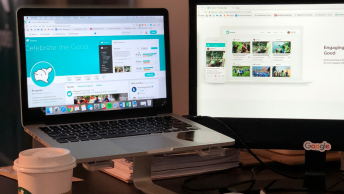As a blogger, it is important to share amazing content with your readers continuously. Our job is to create content that resonates with, educates, and strengthens connections with our audience. On the flip side, if we want to run a successful business, there are so many other things we have to do. We can not spend all day creating content. Let’s chat about how we can write more content in less time so that we can focus on all aspects of our business.
1. Write More
I know this seems like an odd first tip, but one of the reasons I can crank out so many blog posts is because I write a lot. As a student finishing up their Master’s in August and a blogger, I write a ton. Getting my degree while blogging has helped me tremendously because I write content all the time.
Writing is a muscle, the more you use it, the faster and better you get at it.
If you spend just 30 minutes to an hour a day consistently using your writing muscle, it will help you write more content in less time. Or, if you are like me, you can go through years to get a degree that requires you to write a lot. Without my degree, I would not be able to write as fast and as much content as I do every single day.
Write Content With Varying Lengths
You also need to vary up your content lengths when writing. You may want to start with a 500-word write-up, then once you feel comfortable with that, move it up a bit. Take your time to write a little bit more once your current word count feels a bit monotonous.
If you stick with a certain length, you will just get great at writing that length of content. For example, if all you ever did was write 1,000-word articles, that’s what you would continue to be great at. Flex your writing muscle by continuing to increase the content you write. You won’t be able to publish long-form content like e-books and regular books in less time if you are only used to writing 1,000-word articles.
Know You Don’t Have To Publish All The Content You Write
As you are practicing writing content, know that you don’t have to publish everything. Something you write may eventually turn into a blog post, email, or social media update but it doesn’t have to. As a student, I have written plenty of words for assignments that I never end up publishing. Writing this content has allowed me to write more content on a daily basis even though that content was never published. You can reap the benefits of becoming a faster writer with or without publishing.
2. Outline Your Content
I start all blog posts with an outline. Outlining is the most important part of the writing process for me. Starting with a simple outline will help you jump around in your content. It is hard for me to write content from start to finish. There is usually a section further down in the article that excites me, so I write that piece first. Taking a few minutes to think about a topic and come up with a viable outline saves you tons of time in the end.
Creating an outline helps me in many ways, from making it easier to work with different parts of the blog to vetting the viability of a blog post. The outline helps you see if you know as much about the content as you think you do. If you can’t come up with a viable outline, you may not want to continue writing the post at the moment.
The outline for this post was as simple as coming up with all the tips I wanted to use. Then once I came up with those tips, I was able to write the content that excited me most. While all the ideas you write in an article are impactful, it’s important to realize that some tips are harder to write. Having the structure already set up allows you to skip around easier if you get stuck when writing.
Creating a rough outline for a blog takes only a few minutes, but it can speed up the writing process tremendously.
3. Repurpose Old Content
Another way to write content faster is to repurpose old content. You likely have a ton of content in your repertoire that is collecting dust. Repurpose that content to create articles of different lengths.
Turn Your Blogs, E-Books, Courses, Emails, etc. Into Other Content
Let’s break down repurposing further.
As an example, say you have an excellent blog post on the basics of building your digital brand. If you want to repurpose your idea or content, you could:
- Make a more advanced version: If your content was on digital brand building basics, create an intermediate or advanced version of the same post. Depending on your target audience, this may help you bring in more advanced readers.
- Create a podcast or video episode: Some people learn well with audio or video. Create a script based on your old blog post and share that with your audience with audio or video. You can then publish a new article with your podcast episode or video along with show notes to help your audience understand the topic further.
- Write an e-mail series: People love e-mail courses. If you have a particularly meaty article, you can quickly turn that article into an e-mail course for your readers.
Play around with the content that you have already written. Don’t let your content collect dust because you are too afraid to use it again. Re-using content and research that you have already done will help you save a lot of time off of the content creation process.
4. Bounce Off Other Ideas
Are you an avid reader? One awesome way to create more blog content with ease is to cut down on the brainstorming process. There are likely tons of blogs in your niche creating amazing content on a weekly basis. Take a look at the kind of content they are creating and use their ideas as a starting point.
To find other blogs I suggest using Feedly to find other blogs to follow. Take your time weekly to sit down and read other blog’s in your niche to see how they work. Be sure to bookmark your favorite articles or write down their titles in a notebook somewhere.
Make Their Ideas Unique To You
Your goal shouldn’t be to create an identical article. Instead, your goal should be to find your content angle. You have two different audiences so your goal as a writer should be to understand how your audience would benefit from the topic.
Take a few minutes to sit on the idea, look through various headers, and pull out content that seems relevant. What section of the article can you speak to? What part of the article can you enhance?
Once you understand that, you can use their article as the jumping off point of your article.

5. Ask Your Audience For Help
You have an audience for a reason. Your audience members can help you write more content in less time through the following ways:
- Comments: If you have an active audience, they have probably left many questions on your posts. Go back to one of your most popular posts to see the kind of questions they have for you. Figure out how you can use those questions to create content for your blog or business.
- Use Google Analytics & Social Media To See What’s Popular: Commenting doesn’t happen as much as it used to. It’s getting harder to convince people to leave a comment, even with an amazing call to action. What are people doing instead? Visiting and sharing on social media. Use Google Analytics as well as social media analytics to get a glimpse as to what is working for your audience, then create more of that content.
- Surveys & Polls: Sometimes, you just need to ask. Create a quick survey or poll to see what your audience wants to hear from you. The survey doesn’t have to be large, but it is important that your questions are easy to understand.
SEE ALSO: How To Effectively Survey Your Audience
6. Do A Speed Writing Session
One of my favorite things to do when I want to create content, is speed write. I mainly do this when I have an idea right before bed, and I want to get it out of my head before I go to sleep, but this isn’t always the case. So, how does speed writing work? Simple.
Open up a document on your computer and open up a timer on your computer or your phone. Set the timer for 5-10 minutes. Write. Don’t proofread, don’t research, don’t link articles. Just write. You may not even want to stop to add headers. I have never written an entire post during a speed writing session, but I have written about 500 words during a speed writing session before, which is pretty impressive considering most of the content that I put on the internet is around 1,000-2,000 words.
Your speed writing session will more than likely need a lot of proofreading, but sometimes you need a quick sprint to help with the marathon of writing a blog post.
7. Concentrate When You Are Writing
One of the best things you can do to write more content in less time is to focus when writing. To write the best content, you need to be focused on what you are writing. It’s easy to fall into a trap when writing. Usually, you have a million tabs open for various things like researching, getting pictures for your content, et cetera. Whether you are writing a blog, email, or even a social media update, having focus is key.
So, how do you focus? Understand how you create the best content. For me, it’s with The Pomodoro Technique (learn more about this via this article from Lifehack), soft classical/piano music in the background, and no distractions like social media or my cell phone. I create my best content when I am in this ambiance, no matter if I am in my bedroom or at the public library. Find your zen place. Find the place where you are most in tune with your content.
Then once you find that place, continue to visit that place so you can consistently focus while writing. Once I find my writing happy place, I tend to stick with it until it is no longer beneficial for me. You do not need to play around with your writing technique constantly. Do what works until it no longer works.
8. Outsource Certain Parts Of The Blogging Process
Last, but not least, outsource. Sometimes, the easiest thing you can do is outsource certain parts of the writing process. You don’t have to outsource every single aspect of the process, but maybe certain parts would be better off outsourced.
We have recently written a piece all about outsourcing certain blog tasks. Check out this post so that you can begin to think about which elements of the writing process you would rather start outsourcing:
SEE ALSO: 13 Tasks You Can Outsource To Grow Your Blog
If you have the money to outsource, it can be beneficial. Having someone else do your blog research, image creation, editing, etc. frees you up to do the bulk of the writing.
Conclusion
Content creation doesn’t have to be scary. If you follow these eight tips, you will be able to write more content in less time. Writing does take practice, but you are well on your way to being able to write amazing content.
What is your best content creation tip? I want to know all your secrets! Let me know by leaving a comment below.











